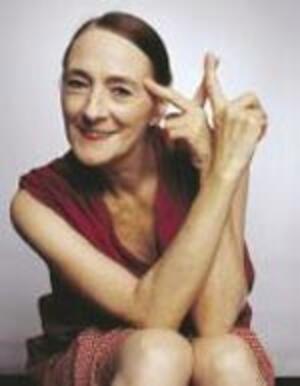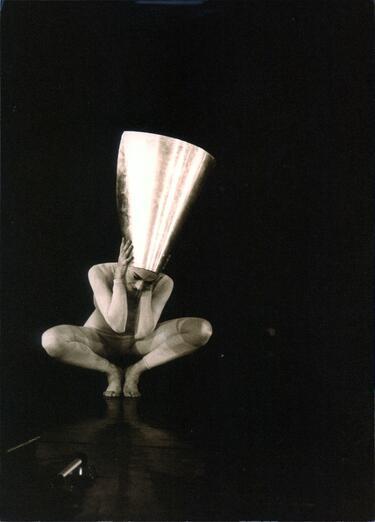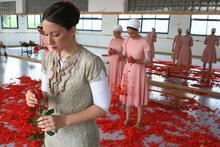Rina Schenfeld
Rina Schenfeld has choreographed solo and company performances that have been presented on important stages around the world. After studying with the classical ballet teacher Mia Arbatova and the Martha Graham style with Rena Gluck, she won a scholarship to study at Martha Graham’s studio and at Juilliard in the United States. After returning to Israel, she was in the first cast of the Batsheva Dance Company and principal dancer appearing in works by Martha Graham, John Butler, Glen Tetley, Robert Cohan, Jerome Robbins, and others. In late 1970s she left the Batsheva Company and established the Rina Schenfeld Dance Theater. She uses objects of daily life to build a world of poetry and dance.
In 1983, Anna Kisselgoff of The New York Times wrote:
Miss Schenfeld’s transformations … take on a philosophical meaning, raising questions about essences. … She keeps the human figure always visible and she is, as ever, a serenely beautiful dancer of great intensity, the magnetic focus of attention.
Rina Schenfeld has choreographed solo and company performances that have been presented on important stages around the world. She uses the objects of daily life for her props and creates a poetic world with them. Her choreographic explorations with props changed over the years, starting with geometric creations, which focused on props with clean geometric lines that meet those of the dancer’s body and create associations and restrained drama; works of nature, during which she used natural props such as hair, water, wind,; and a work in which she investigated reflections and plays of light and shadow. Later, Schenfeld turned to merging video and to using her own original songs in her work. Recently she has turned to masks.
Early Life and Dance Education
Rina Schenfeld was born in Tel Aviv on December 15, 1938. Her father, Israel Schenfeld, a salesman, and her homemaker mother Dvorah (née Zekel), were both born in Komarno, Poland. They had a son, Abraham Elihu, who was born in 1933.
Rina Schenfeld began her studies at the end of the 1950s with the classical ballet teacher, Mia Arbatova. Between 1956 and 1959, she studied the Martha Graham style at the studio of Rena Gluck, also appearing in Gluck’s company. In 1959, she won a scholarship to study at Martha Graham’s studio and at Juilliard in the United States.
Early Evolution as a Dancer
After Schenfeld’s return to Israel in 1962, she danced with the Lyric Theater of Anna Sokolow. A year later, she appeared with her own company, the Rina Schenfeld Dance Group, which presented only one program. Schenfeld was also the Batsheva Dance Company’s principal dancer from 1964 to 1977, appearing in works by Martha Graham, John Butler, Glen Tetley, Robert Cohan, Jerome Robbins, John Cranko, Mirali Sharon, Moshe Efrati, Rina Yerusalmi, and others. During this period, a series of artistic directors atBatsheva change frequently and in result it strengthened the status of Schenfeld, who, along with soloist Rena Gluck and general manager Pinhas Postel, felt responsible for the company’s continued existence in the midst of a stormy sea of difficulties. Schenfeld created several works for Batsheva, including Jephthah’s Daughter (1965), Blind Man’s Buff (1967), Curtains (1969), and Corners (1973). Although these dances were well received, Schenfeld’s talent as a dancer overshadowed her talent as a choreographer.
In 1977 Schenfeld took a year’s leave of absence from Batsheva and began to work on her first solo program. She felt the need for a change and new challenges. Merce Cunningham’s company came to Israel that year. Interviewed by journalist Sarit Fuchs, Schenfeld said: “I watched all four of Merce’s performances. In each one he changed the order of the dance and assembled a new narrative on the basis of the same units…. This amalgam, this ability to play with subtleties, to set up and dismantle situations, exactly as things happen in life – bowled me over.” The Paris Opera Workshop, headed by Carolyn Carlson, also visited in 1977 and left a profound impression on Schenfeld. With lighting designer John Davis and French composer Igor Wahkévitch, Carlson set the stage for an amazing spectacle of surrealistic images of light, color, objects, and movement.
Schenfeld described her approach as “architecture dance” and said she was looking for pure movement and a clean line. The objects were everyday – poles, elastic, nylon bags, cubes, and balloons – but she did not leave the things in their natural state. The wooden cube was very precisely designed, the poles were polished, and the tin surface was an exact parallelogram. The objects, like the body, radiated spotlessness, precision and quality of execution.
The Rina Schenfeld Dance Theater
In 1978 Schenfeld left the Batsheva Company and established the Rina Schenfeld Dance Theater. That same year, she staged her first solo performance, Threads, her biggest success as an independent and innovative choreographer and a wonderful example of her geometrical dances with props. Composer Wahkévitch’s electronic music was inspirational; lighting designer John Davis’s beams lit and sculpted the stage, lit the props from different angles, and reinforced the imagery, a new approach in Israel at the time; and sculptor Ziva Lieblich deepened her understanding as she “opened her eyes” to look at objects with the eyes of a sculptor.
In the first part of Threads, the dancer messes about with a ball of tangled string, much as children do in Cat’s Cradle. Next two long white poles extended the body’s movement into the space. The line in space then became three dimensional when cubes were brought onto the stage, carrying the dancer forward in space. In the central part of the work, Schenfeld danced with a refrigerator-sized cardboard box, which, flattened and spread out by the dancer, became a prayer dance. In the final section, Man Walks in his Threads, Schenfeld performed amid four thin pillars with the dancer stringing elastic among the pillars until she had fashioned a net. Giora Manor’s review reported: “Now she’s a spider, both spinning, and becoming entrapped in, its web, and the clear, crisp lines create the perspective of a super-modern city, whole vistas onto an imaginary world. The human figure in this ribcage of lines becomes mechanical, creating an almost robotic effect, such as the Bauhaus artists of the 1920s and ’30s strove for in their theater and dance shows, mainly in Schlemmer’s triadic ballet.”
The mix of a quality program and her reputation as Batsheva’s former principal dancer opened doors to prestigious festivals in Israel and abroad, such as The Next Wave (1983) at the Brooklyn Academy of Music (BAM), intended for the avant-garde.
Schenfeld created many works, including Tins and Hair Dance (1980). In the first part she danced with a tin can, experimenting its geometrical rectangle, both flexible and rigid. In the second part, the antithesis to a can, she danced with her hair, a primary element, natural, organic, intimate, attached to the living body. She spread her long hair out, tossed it, moved her head and it responded, just as one would in daily life; at the same time, she acted as though it was not part of her body, but rather a prop she found in the street and turned into a mask and a whip. Her use of hair was an opening for her later use of natural materials.
In another notable dance from the 1980s, It’s Summer in my Room (1987), Schenfeld experimented with wind created with the aid of four plastic fans stacked one atop the other, like a looming statue. She danced with long, elaborate, very personal silk gowns, such as one might find in Grandma’s closet. Later, the gowns were hung on thin strings fastened to the ceiling and danced next to the dancer, while the wind produced by the electric motors blew life into them. In 1990 she created Light, Azure and Shadow, Winter ’91 (1991), experimenting with sources of lights projected on her from different angels while dancing with her shadow which changes sizes. In Eudaimonia (1998), she experimented with words.
Growing the Next Generation
At the start of the 1980s Schenfeld established a workshop that presented a number of programs that she choreographed with her students. The most notable of these was Sculpting on the Wall (1982), performed outside and integrating the exterior urban landscape against the background of a meters-high wall adjoining the YadLeBa’nim building in Tel Aviv. The evening was composed of a mosaic of pieces by the 17 workshop dancers set to the music of American artist/composer Laurie Anderson. That same year Schenfeld made Other Days and Beaches to the music of Phillip Glasses’ opera Einstein on the Beach (1975), with Robert Wilson’s multi-media direction. In 1984 she brought the workshop’s new summer program, Ballad, Necklace, Autumn 2, 3, 4, to the Tel Aviv Museum. Leskly wrote in Ha’Ir: “The new dance theater program looks like a long line of ideas, some brilliant, others failing; yet even the mediocre have presence. … Despite the faults, one thing is perfectly clear: Rina Schenfeld’s workshop is the only serious ‘nursery’ to be fostering a new generation of significant dancers. Meanwhile we have to be patient and wait for the moment that thinking will lead the legs to their proper destination.” Many young dancers and choreographers graduated from her school to form their own companies, which operate in Israel and throughout the world.
Rina Schenfeld Dance Theatre Retrospective.
At the age of 80 Schenfeld continues to create and dance. After the mid-1990s she gradually lost her place as an important figure in the Israeli dance scene, but her past accomplishments still guarantee her a loyal fan base.
Honors and Awards
In 1998, Rina Schenfeld published her first book of poetry, You’ll Dance, I’ll Tumble. Her work has won many prizes: the Golden Star Medal (1971), the Kinor David (David’s Harp) awards of 1979, 1980 and 1982, the Na’amat prize for her life’s work in the field of dance (1994), the Israel Ministry of Education and Culture’s Creativity Prize (1997), Israel Festival of Jerusalem Prize (2000), the Landau Prize for Stage Arts (2001) and the Israel EMET Prize for Culture and Art: Classical Music and Dance, under the auspices of the Prime Minister’s Office (2003).
A Conversation with Riina Schenfeld.
In 1964 Rina Schenfeld married Uri Figenblat, a shoe designer. They have two children: a daughter, Tamar, born January 12, 1968, and a son, Israel, born June 17, 1974.
Selected dances by Rina Schenfeld:
Silk Sticks and Balloons (1983).
Waves (1986).
Summer (1993).
Jacob’s Dream (1990).
Remember Me (1990).
Tales of Eden (1990).
Bubbles (1992).
Sham Mayim (1995).
The Angel Came at Night (1997).
Pillar 20/40 (celebrating forty years of choreography, 1999).
Woman in White (2000).
Wings Close Up (2001).
Swans (2002).
Dance Me to the End of Love (2008).
Notes to Pina Bausch (2014).
Waltz at Five Thirty (2013).
Dancer Forgets her Steps (2016).
Stand Up Tragedy (2018).
Mask (2019).
Lioness (2019).
Anderson, Jack. “Dance, Music and Stage, Triply Complex Mating.” The New York Times, December 15, 1983.
Di-Nur, Daniel. Rina Schenfeld Dance Theater: A Retrospective, 1960–2000. Israel: 2000. (Hebrew and English)
Eshel, Ruth. Dancing with the Dream: The Beginning of Artistic Dance in Israel, 1920–1964 Tel Aviv: Sifriyat Hapoalim and the Dance Library of Israel 1991. (Hebrew with English summary.) Available at https://www.israeldance-diaries.co.il/en/about/books/
Eshel, Ruth. “Props in Israeli Dance,” with the participation of Rina Schenfeld, Ido Tadmor and Ruth Ziv Eyal, The Academic Chanel, 1999.
Eshel, Ruth. Movement Theater in Israel 1976–1991 (Hebrew with English summary). Ph.D. diss, Tel Aviv University,2001.
Eshel, Ruth. Dance Spreads its Wings: Israeli Concert Dance 1920-2000. Tel Aviv: Israeldance-Diaries.com, 2016.
Fuchs, Sarit. “The Silkworm,” Ma’ariv, 29 June 1979.
Harlev, Shai. “To do something with Nature: Rina Schenfeld Celebrates 40 Years of Dancing.” Mahol Akhshav (Dance Today) 1, April 2000, 24-28. Available at https://www.israeldance-diaries.co.il/en/magazines/dance-today/.
Leskly, Hezi. “A Goodwill Seesaw,” HaIr, 10 August 1984.
Kisselgoff, Anna. “Dance: Rina Schenfeld in Three Long Solos.” The New York Times, November 11, 1983.
Manor, Giora. “A Wonderful Evening with Rina Schenfeld,” Al Hamishmar, 22 August 1978.
Rina Schenfeld file at the Israeli Dance Library at Beit Ariela, Tel Aviv.
Sowden, Dora. “Waves of Talent.” Jerusalem Post, February 21, 1982.






